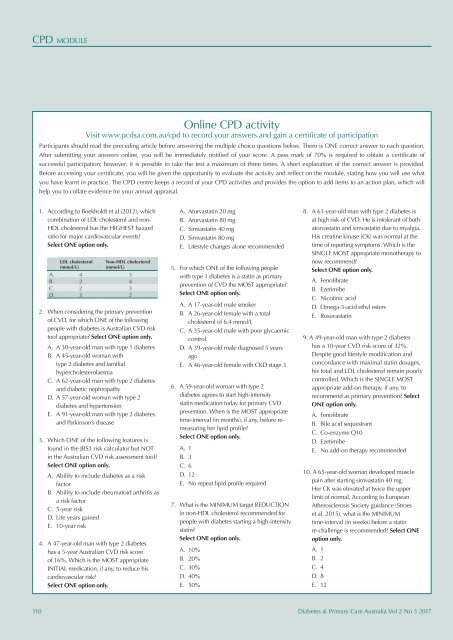DPCA 2-3_entire_v3
Create successful ePaper yourself
Turn your PDF publications into a flip-book with our unique Google optimized e-Paper software.
CPD module<br />
Online CPD activity<br />
Visit www.pcdsa.com.au/cpd to record your answers and gain a certificate of participation<br />
Participants should read the preceding article before answering the multiple choice questions below. There is ONE correct answer to each question.<br />
After submitting your answers online, you will be immediately notified of your score. A pass mark of 70% is required to obtain a certificate of<br />
successful participation; however, it is possible to take the test a maximum of three times. A short explanation of the correct answer is provided.<br />
Before accessing your certificate, you will be given the opportunity to evaluate the activity and reflect on the module, stating how you will use what<br />
you have learnt in practice. The CPD centre keeps a record of your CPD activities and provides the option to add items to an action plan, which will<br />
help you to collate evidence for your annual appraisal.<br />
1. According to Boekholdt et al (2012), which<br />
combination of LDL cholesterol and non-<br />
HDL cholesterol has the HIGHEST hazard<br />
ratio for major cardiovascular events?<br />
Select ONE option only.<br />
LDL cholesterol<br />
(mmol/L)<br />
Non-HDL cholesterol<br />
(mmol/L)<br />
A. 4 3<br />
B. 2 4<br />
C. 2 3<br />
D. 3 2<br />
2. When considering the primary prevention<br />
of CVD, for which ONE of the following<br />
people with diabetes is Australian CVD risk<br />
tool appropriate? Select ONE option only.<br />
A. A 30-year-old man with type 1 diabetes<br />
B. A 45-year-old woman with<br />
type 2 diabetes and familial<br />
hypercholesterolaemia<br />
C. A 62-year-old man with type 2 diabetes<br />
and diabetic nephropathy<br />
D. A 57-year-old woman with type 2<br />
diabetes and hypertension<br />
E. A 91-year-old man with type 2 diabetes<br />
and Parkinson’s disease<br />
3. Which ONE of the following features is<br />
found in the JBS3 risk calculator but NOT<br />
in the Australian CVD risk assessment tool?<br />
Select ONE option only.<br />
A. Ability to include diabetes as a risk<br />
factor<br />
B. Ability to include rheumatoid arthritis as<br />
a risk factor<br />
C. 5-year risk<br />
D. Life years gained<br />
E. 10-year risk<br />
4. A 47-year-old man with type 2 diabetes<br />
has a 5-year Australian CVD risk score<br />
of 16%. Which is the MOST appropriate<br />
INITIAL medication, if any, to reduce his<br />
cardiovascular risk?<br />
Select ONE option only.<br />
A. Atorvastatin 20 mg<br />
B. Atorvastatin 80 mg<br />
C. Simvastatin 40 mg<br />
D. Simvastatin 80 mg<br />
E. Lifestyle changes alone recommended<br />
5. For which ONE of the following people<br />
with type 1 diabetes is a statin as primary<br />
prevention of CVD the MOST appropriate?<br />
Select ONE option only.<br />
A. A 17-year-old male smoker<br />
B. A 26-year-old female with a total<br />
cholesterol of 6.4 mmol/L<br />
C. A 35-year-old male with poor glycaemic<br />
control<br />
D. A 39-year-old male diagnosed 5 years<br />
ago<br />
E. A 46-year-old female with CKD stage 3<br />
6. A 59-year-old woman with type 2<br />
diabetes agrees to start high-intensity<br />
statin medication today for primary CVD<br />
prevention. When is the MOST appropriate<br />
time-interval (in months), if any, before remeasuring<br />
her lipid profile?<br />
Select ONE option only.<br />
A. 1<br />
B. 3<br />
C. 6<br />
D. 12<br />
E. No repeat lipid profile required<br />
7. What is the MINIMUM target REDUCTION<br />
in non-HDL cholesterol recommended for<br />
people with diabetes starting a high-intensity<br />
statin?<br />
Select ONE option only.<br />
A. 10%<br />
B. 20%<br />
C. 30%<br />
D. 40%<br />
E. 50%<br />
8. A 61-year-old man with type 2 diabetes is<br />
at high risk of CVD. He is intolerant of both<br />
atorvastatin and simvastatin due to myalgia.<br />
His creatine kinase (CK) was normal at the<br />
time of reporting symptoms. Which is the<br />
SINGLE MOST appropriate monotherapy to<br />
now recommend?<br />
Select ONE option only.<br />
A. Fenofibrate<br />
B. Ezetimibe<br />
C. Nicotinic acid<br />
D. Omega-3-acid ethyl esters<br />
E. Rosuvastatin<br />
9. A 49-year-old man with type 2 diabetes<br />
has a 10-year CVD risk score of 32%.<br />
Despite good lifestyle modification and<br />
concordance with maximal statin dosages,<br />
his total and LDL cholesterol remain poorly<br />
controlled. Which is the SINGLE MOST<br />
appropriate add-on therapy, if any, to<br />
recommend as primary prevention? Select<br />
ONE option only.<br />
A. Fenofibrate<br />
B. Bile acid sequestrant<br />
C. Co-enzyme Q10<br />
D. Ezetimibe<br />
E. No add-on therapy recommended<br />
10. A 65-year-old woman developed muscle<br />
pain after starting simvastatin 40 mg.<br />
Her CK was elevated at twice the upper<br />
limit of normal. According to European<br />
Atherosclerosis Society guidance (Stroes<br />
et al, 2015), what is the MINIMUM<br />
time-interval (in weeks) before a statin<br />
re-challenge is recommended? Select ONE<br />
option only.<br />
A. 1<br />
B. 2<br />
C. 4<br />
D. 8<br />
E. 12<br />
110 Diabetes & Primary Care Australia Vol 2 No 3 2017
















